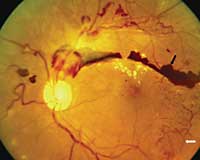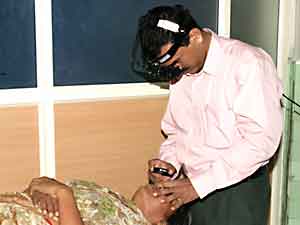Physicians battle India’s diabetic retinopathy crisis
Click Here to Manage Email Alerts
 G. V. Rao |
As lifestyles and diets change, diabetic retinopathy is becoming an increasingly serious threat to eye health in India. Compounding this problem is the fact that treatment is mostly limited to urban tertiary care centers, which are unable to meet the needs of the entire population.
G.V. Rao, PhD, director of Indian operations for Orbis International, spoke with Ocular Surgery News about the prevalence of diabetes and diabetic retinopathy — its most common complication — in India.
“India has long passed the stage of a diabetes epidemic,” he said.
Diabetes affects roughly 20 million Indians and is likely to affect 57 million by 2025. This means India will continue to have more people with diabetes than any other country, he said, citing statistics from the World Health Organization (WHO).
The rapid increase in cases is due to several factors, according to the WHO, including the asymptomatic nature of the disease in its early stage, the high dropout rate of patients and a lack of critical information.
“It is estimated that there may be 11 million to 20 million people with diabetic retinopathy by 2025, including 5.7 million people with severe retinopathy,” Dr. Rao said.
|
|
Images: Hussain N |
Treatments across India
The most advanced diabetic retinopathy treatment in India is being performed at urban tertiary care centers, where general ophthalmologists can refer their diabetic retinopathy patients for medication and laser treatment.
Nazimul Hussain MS, DNB, a vitreo-retinal consultant at L.V. Prasad Eye Institute, in Hyderabad, spoke with OSN about how his center treats diabetic retinopathy.
“We are well-equipped and have a state-of-the-art facility, including seven well-trained, skilled medical and surgical retinal specialists to handle diabetic retinopathy,” he said. “We use 532 nm green lasers and a micropulse diode laser in the outpatient clinic and 810 diode laser as well as 532 nm green in the operating room during diabetic vitrectomy.”
Dr. Hussain said he uses anti-vascular endothelial growth factor agents selectively in cases of extensive and active fibrovascular proliferations or diabetic macular edema. His center is a test site for clinical trials of a fluocinolone acetonide implant for diabetic macular edema and Macugen (pegaptanib sodium, OSI/Pfizer) for diabetic retinopathy, he said.
He noted that vitrectomy is indicated in cases of nonresolving vitreous hemorrhage, tractional retinal detachment, progressive fibrovascular proliferation, premacular fibrosis, or combined retinal detachment and premacular hemorrhage.
“At present, there is a gross difference in the accessibility of diabetic retinopathy treatment in the rural areas. This is primarily due to a lack of human resources and infrastructure facilities,” Dr. Hussain said.
He said efforts must be made to ensure that laser treatments and screening facilities are available to every citizen.
“Only those areas that are covered by tertiary level eye care institutes through their community outreach programs refer the potential patients,” Dr. Rao said, stressing that this type of outreach is essential and only in its initial stages.
Fighting diabetic retinopathy
According to Dr. Rao, most general ophthalmologists lack the necessary equipment to detect diabetic retinopathy in its crucial early stages, when the disease is most sensitive to treatment.
“Diabetic retinopathy is often symptomless in the early stages,” Dr. Rao said. “Lots of diabetic retinopathy cases remain undetected, as there are only few tertiary level care centers that have diagnostic tools such as a slit lamp, ultrasound and procedures such as fluorescein angiography.”
To combat this unbalance, programs are under way to increase awareness and bring treatment to all patients.
In May 2003, Aravind Eye Hospital initiated a program to generate awareness, deliver services and training, and deal with problems of diabetes and diabetic retinopathy in the community, Dr. Rao said.
In 2006 and 2007, Aravind screened 70,993 patients in 451 diabetic retinopathy “screening camps.” Of these patients, 18,084 had diabetes and 3,385 of them suffered from diabetic retinopathy, according to Aravind’s Web site.
The L.V. Prasad Eye Institute began its own programs as well, Dr. Hussain said. Last year, his department initiated a diabetic retinopathy prevalence study as well as a diabetic screening program, called “Lions Diabetic Project.”
With this project, L.V. Prasad created diabetic retinopathy screening centers and made efforts to install laser machines for easy accessibility, Dr. Hussain said. Ophthalmologists from those centers and from the Andhra Pradesh state are being trained in assessing diabetic retinopathy and performing laser treatments. Deserving candidates from India as well as from abroad are also trained in retinal lasers at the Zeiss Retinal Laser Training Centre.
“At the end of the program, they are able to perform lasers treatments independently and proficiently,” he said. “We already have working centers in the city and in the peripheries.”
|
Image: Courtesy of Orbis |
Making progress
Although the diabetic retinopathy programs started by Aravind and L.V. Prasad have been successful, Dr. Rao said they are too small and piecemeal to address the entirety of the problem.
“Such efforts are done by only a few organizations and cannot cover the whole country,” he said. He added that the country’s ophthalmology infrastructure is insufficient for meeting the needs of all Indians with diabetic retinopathy.
He noted some progress, however. A national blindness prevention action plan recently submitted to the government of India by the Ministry of Health and Family Welfare included a plan for controlling diabetic retinopathy. The plan was developed in part by Vision 2020: the Right to Sight — India and outlined several interventions related to developing human resources, strengthening infrastructure and delivering diabetic retinopathy services. Slated for approval this year, the action plan will remain in effect until March 2012, according to Dr. Rao.
Regardless, he said, “no one, including the government and nongovernmental organizations, is focusing on behavior change communication.”
Orbis International has conceptualized a pilot intervention model called “Save Your Sight,” which was scheduled to start in July in Maharashtra and West Bengal, he said.
“The model is designed to increase awareness and knowledge of the importance of early detection of diabetic eye disease in preventing visual loss and to motivate people with diabetes to seek eye care,” Dr. Rao said. “The project will identify current education efforts and the most critical gaps in public knowledge, attitudes and practices. Major focus will be placed on encouraging potential diabetic patients to get diagnosed and making eye checkups a priority.
“Key areas of focus will be self-identification of potential diabetic retinopathy patients, increasing awareness of the availability of services and projecting diabetes as a serious disease that requires attention and regular treatment,” Dr. Rao said. “For physicians, the project also will develop an essential and standard protocol for diabetic retinopathy treatment and a referral system for early detection and treatment.”
The pilot program will last 3 years, during which time Orbis International aims to reach 22,000 patients. Based on the results and findings of the pilot program, Orbis International will construct a nationwide behavior change plan in association with Vision 2020 and the Indian government.
“Orbis will also help build capacity of local hospitals by providing training to doctors and paramedics to identify and treat diabetic retinopathy patients,” Dr. Rao said.
For more information:
- G.V. Rao, PhD, can be reached at Orbis India, All India Ophthalmic Society Building, A-8 Institutional Area, Karkardooma, Delhi, 110092; +91-11-22376301; fax: +91-11-22376304; e-mail: g.rao@in.orbis.org; Web site: www.orbis.org.in.
- Nazimul Hussain MS, DNB, can be reached at L.V. Prasad Eye Institute, L V Prasad Marg, Road No. 2, Banjara Hills Hyderabad 500 034, India; +91- 40-30612345; fax: +40-23548271; e-mail: nazimul@lvpei.org.
- L.V. Prasad Eye Institute can be reached at LV Prasad Marg, Banjara Hills Hyderabad 500 034, Andhra Pradesh, India; +91-40-3061-2345; fax: +91-40-2354-8271; Web site: www.lvpei.org.
- Aravind Eye Hospital (Madurai), can be reached at 1, Anna Nagar, Madurai - 625 020, Tamil Nadu, India; +91-452-4356100, 243-2653-7; fax: +91-452-2530984; Web site: www.aravind.org.
- Andy Moskowitz is an OSN Staff Writer who covers all aspects of ophthalmology.



